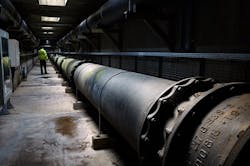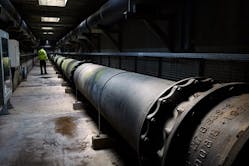Spending millions of pounds per year unblocking its sewer network, utility Severn Trent needed a solution fast. Over three months, it worked to put in place a real-time analytics solution and combine it with rainfall data to pre-empt anomalies in its infrastructure.
By David Brakoniecki
UK-based Severn Trent Water (STW), which provides sewage services to more than 4.3 million homes and businesses, was spending nearly £10 million annually to clear 55,000 blockages throughout its lines. With 94,000 kilometers of sewers to oversee and maintain, Severn Trent Water’s network could wrap around the globe 2.5 times. To detect a potential blockage, the utility turned to software made by IBM to spot problems in the sewer network with telemetry devices that monitor the sewer.
Monitors miss the mark
About five years ago, Severn Trent Water installed about 500 monitors in its sewer network, and the utility engaged a third party to relay the data from these devices. The third party charged a significant sum of money to observe the monitors. But the contract workers often missed the fact that a blockage in the lines was forming. STW was getting very little, and in some cases no, advance notice of blockages, so the utility often scrambled to prevent environmental issues such as overflows.
Additionally the utility had a regulatory commitment to increase the number of monitors, or loggers, from 500 to 4,000, which would have cost significant sums to monitor via the existing arrangement.
The utility decided to improve things by taking on oversight and deployment of the monitoring project. One of the first orders of business was putting in place a real-time analytics solution. Up-to-the second data and analysis would give Severn Trent Water’s managers and crews time to attack, or even prevent, sewer blockages before the obstructions did any environmental damage.
According to Andy Henton, an information systems architect for Severn Trent Water, the utility has had a long-standing relationship with IBM as a technology and systems integration partner. When the utility discussed its challenges with the monitoring sensors, IBM suggested that Henton and his colleagues at Severn Trent Water also work with BP3 Global.
“Between October and December 2015, we made sure we had the right product in-house for data and analysis,” says Henton. “Beginning in January 2016, there was a three-month piece of work with BP3 Global and IBM to look at the form of the data we were getting from these monitors, combine it with rainfall and do something meaningful with the results.”
Hydraulically, remarks Henton, the utility’s network of sewers reaches a moment where all the rainfall and waste comes to an overflow point. It was BP3 Global’s task to look at the data from the network of installed monitors and correlate the performance of the sewers with rainfall data during various times relative to a baseline of normal operation and this overflow point.
Rewriting the rules for monitoring pollution
With IBM Operational Decision Management (ODM), BP3 Global helped establish the right set of guidelines within the rules engine to make the data from the monitors actionable. IBM ODM is a software platform for managing business rules. IBM ODM allows Severn Trent Water’s engineers and mathematicians to pull out the rules hidden away in computer code, externalise these rules and change the rules to meet a pressing business need.
“IBM ODM is like a Lego model you buy off a toy store shelf; it comes with a variety of blocks that its owner can build with or rearrange in new combinations,” says Ben Ariss, BPM and business rules consultant for BP3 Global. “When you don’t have enough blocks in the shapes or sizes that you need or you want an entirely new type of block to build with, BP3 comes in and gives a user what they need to create the structure they want, when they want it.”
The analysis entailed developing and editing a complex set of rules to quickly identify when sewer performance was deteriorating. Some of the rules gave Severn Trent’s engineers and mathematicians a way to include their hydraulic and rainfall models into the utility’s monitoring system to get more accurate reports. With its rules, BP3 Global took into account a sewer line’s normal rate of flow and velocity, so Severn Trent Water could implement models for each sensor location. The engineers could then calibrate an ordinary reading for each sensor and give the device a way to detect if a new reading was outside the normal range. This empowered them with the ability to detect and rectify a deteriorating situation in the sewer before it evolved into a blockage or pollution incident.
Integrating this data with other IT systems enabled Severn Trent Water to raise an alarm and generate a work order in its work management system. As a result, the utility’s managers would have more time to identify and coordinate the right response to deal with a blockage. In practical terms, better data-crunching and rules-writing for the monitors gets an engineering team (with the right equipment) moving faster to safely restore service.
“The key, and very important, piece of work that BP3 Global provided was diagnosing what was happening – and not happening – with our monitors and architecting a set of business rules for spotting the overflow problem with time to spare,” adds Henton. “The job of IBM was to effectively integrate BP3 Global’s work into our SCADA system to generate alarms.”
The project went live at the end of March 2016. Since then, the utility has reduced the number of “pollutions,” or sewage overflow. Within three years, the utility hopes to have 5,000 monitors installed across its sewer network.
“This solution makes us more proactive with pollutions,” remarks Henton. “BP3 Global had never worked with a water company before, but they explored how our network operates, engaged us about our concerns and their collaboration was impressive.”
According to Severn Trent Water, BP3 Global enabled the hydraulic modelling team to reconfigure the business rules they needed in an almost natural language, which spared the team from having to call on time-strapped internal IT resources for development help. Ultimately, this sped up deployment of the project.
Author's note: David Brakoniecki is BP3 Global's managing director for Europe.





